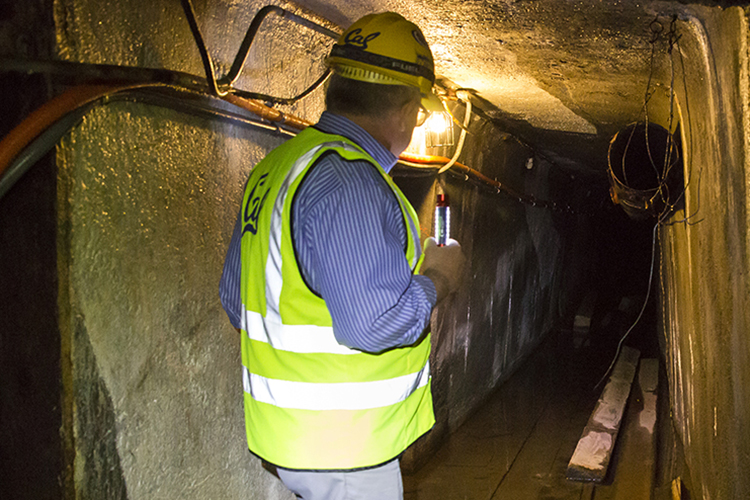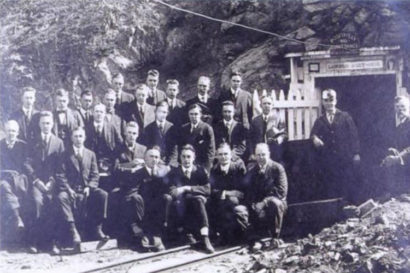Hidden Berkeley: Inside the campus mine
UC Berkeley’s Office of Communications and Public Affairs was recently given a behind-the-scenes tour of the mine, a rare glimpse at the campus’s mining history — follow along

July 27, 2017
The UC Berkeley campus is filled with secret spaces and little-known places. Some are closed to the public, while others are hiding in plain sight. Hidden Berkeley is an occasional photo essay series that shines a light on the hidden places that add to Berkeley’s lore.
Hidden on the north side of campus, locked behind a metal-grated door but visible if you know where to look, are 900 feet of UC Berkeley’s mining history. The door leads to the Lawson Adit, a mine blasted into the Berkeley hills — directly across the Hayward fault — more than 100 years ago by students.
Berkeley scientists have long been among the best in the world, and that was no different a century ago, when the campus was a leader in the science and technology of mining. The adit is named after Andrew Lawson, a pioneering geology professor in the the College of Mining who is credited with identifying and naming the San Andreas fault. For decades, students in the college learned proper mine-building skills, how to safely handle explosives and how to rescue trapped miners.
In the 1970s, in large part to keep fraternities from forcing pledges to spend the night deep in the mine, the adit was sealed from the public. It is rarely visited today by anyone except those who maintain the mine and check on its earthquake-monitoring equipment.
UC Berkeley’s Office of Public Affairs was recently given a behind-the-scenes tour of the mine, a rare look into the campus’s mining history. Follow along as we take you deep inside.
[image360 image_id=”62940″ caption=”Drag around the image for a 360-degree view inside the Lawson Adit. Scroll left to see the mine entrance. Scroll right to see where where the mine splits into two tunnels. 360 image by Stephen McNally”]
Wearing a hard hat, headlamp and tall rubber boots, Scott Shackleton, assistant dean in the College of Engineering, walks on planks that carry him above puddles of water in the mine. He shines a light on cracks that run down the rocks walls, where roots have penetrated the stone. The weather is warm outside, but it’s cooler underground.
“It’s like a wine cellar in here,” Shackleton said, his voice echoing off the walls. “The temperature in here is the same no matter what time of year it is.”
Shackleton oversees the mine and has spent a lot of time cleaning it in recent years so that it can be used for earthquake monitoring.
The mine crosses the infamous Hayward fault, and about two years ago seismologists asked to place some of their monitoring equipment in the mine, so the adit was outfitted with power, high-speed internet and Wi-Fi.
“Right here is your seismographic station,” Shackleton said. “Super fancy, two red boxes.”
An accelerometer in each box monitors the earth’s movement and reports the data to the seismological station in McCone Hall.
The mine was dug by Berkeley students, starting in 1916.
“They were paid, I think, a dollar an hour,” Shackleton told the San Francisco Chronicle in an interview about the seismological monitoring in the mine.

Dean Andrew Lawson (far right) and 1917 mining students sitting in front of the mouth of Lawson Adit. (Click to expand.)
Students carried in boxes of dynamite, blasted and carted out the rock, then installed wood reinforcements and ventilation.
“What they would do is drill a hole, stick in a charge, light it and run. Extend the rails and then cart all the rocks out,” Shackleton said.
Originally, the mine extended only 200 feet, but in the 1940s it was extended to 900 feet.
“This is one of the few mines that was deliberately drilled into a fault,” John Pruynes, a1939 Cal graduate in mining and metallurgy, told the Berkeleyan in 2002. “The first 200 feet were experimental tunnels, but we drove that mine on to about 900 feet, right into the Hayward Fault zone.”

The mine is aligned with the door of a nearby building and rails used to extend into the building, where ore was taken for processing. The mine operated like that for years until the Loma Prieta earthquake in 1989 triggered a collapse around 200 feet into the mine. Some carts are still deep in the mine, blocked by the rubble.
The adit is still lined with the original timber braces from 1916. Mine carts ran on the old rails that are still visible today, as are the alcoves and side shoots where students stashed explosives. Dynamite holes can still be found in the rock walls.
Most of the mine looks like a scene from a Western movie, but the mine transitions to concrete as it runs under a lab. The concrete supports the building’s weight.
Today the adit is maintained only to the collapse. Keep scrolling for more exclusive pictures from inside the mine.

 \
\